|

from
TheHarrowing Website
1. Groping the Pope
Being pope used to require
real balls – and the one chosen actually had to prove it!
Somewhere in the Vatican Museum is said to be a most unusual throne.
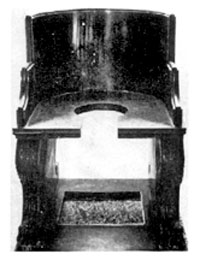
Original Caption:
"The sedia stercoraria in the Vatican Museum.
It is kept in a small room with no mention of its infamous past
role."
"It's a strange object. There is,
for a start, something curious about its proportions. The seat
is very high and has cut into it a keyhole shape, the stem open
to the front. On closer examination it could be an elderly,
rather grand commode, once used by popes.... However, the chair
back is at a curious reclining angle, far too relaxed, it would
seem, for any practical bodily movement. And the legs, too, are
unusual... leaving the centre, under the keyhole, open and
uncluttered."
"Variously known as the sedia stercoraria – which
translates as the 'dung chair'– or rather more understandably,
as the 'pierced chair', this then was the object used to test
the sex of newly installed popes... Any candidate chosen by his
peers to occupy the papal throne was required, before his
election could be verified, to sit on this elaborate seat while
a young cardinal took advantage of the design to touch his
testicles." [1]
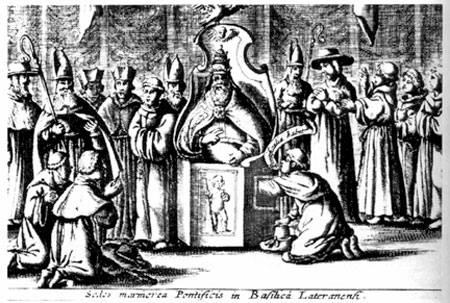
Original Caption:
"An illustration that accompanied an account by the Swedish
traveller Lawrence Banck, of the coronation in 1644 of Pope
Innocent X. Innocent is seated in the sedia stercoraria and
having his testicles felt by a young cardinal as a way of
ensuring that he is a man." The man appears to be exclaiming in
Latin, "The pontiff has them," much to the relief of everyone.
Medieval eyewitness accounts give no
doubt that at one time, this chair and others like it were indeed an
important part of the papal coronation ritual. But why should the
cardinals be so concerned that they would go through the
embarrassment of publicly probing their new boss to demonstrate that
the pope is indeed a
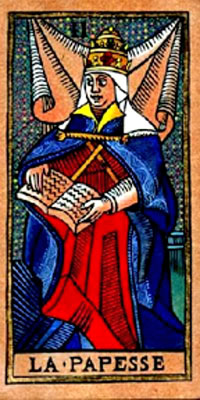 male? male?
(It wasn't done quietly, either. If all
was as expected, the examining cardinal was supposed to call out,
"He has two balls, and they are well hung.")
An odd tradition even for such a
woman-hating church as that of Rome – unless, of course, they had
good reason to worry. Unless, that it, there once was a pope who
wasn't a member of the boys' club.
Interestingly enough, there are ancient and persistent legends,
vigorously denied to this day by the Church, about such a feminine
papacy. "Pope Joan," she is called, and her story is recorded by
some 500 medieval chronicles.[2]
She is said to have been an English woman posing as a man who
entered the Church and became a great teacher, bishop and was
ultimately elected pope, as John VIII in 855.
She supposedly reigned for two years,
secretly taking a lover. Her secret was finally revealed when she
gave birth to a child in the street during a papal procession,
whereupon she and her lover were either stoned or hung upon the
spot. The popes, it is said, have superstitiously avoided taking
that same route ever since.
Monuments were made, but later destroyed
or altered, especially after the Reformation, when her tale was used
to further embarrass Rome.
Pope Joan, if she existed, still exerts a certain fascination. The
Tarot card known as The Popess may well be a reference to
her. There have been many books and plays about her story, but
apparently no films.
It is not known when – or even if – this strange custom was
discontinued. It could go on, for all we know, as one of the secret
rituals of the electoral conclave.
2. The Biggest
Hat
In the nearly two millennia of the title of Roman pontiff having
been a Christian one, many customs have come and gone. For instance,
the papal tiara, no longer seen, was an item popes once wouldn't be
caught dead in public without not long ago. A tall, grandiose
cone-head-shaped triple-layered crown, it grew through the centuries
from a simple beehive or conical shape much like a dunce-cap.
Originally a,
"simple hat made of white cloth in
the shape of an elongated helmet, which may have been derived
from the diadem that, according to legend, Constantine gave to
Pope Sylvester." [3]
Perhaps, but the papal public relations
office once also claimed that Constantine had also most generously
donated Italy and most of Europe to the pope, too, a claim proven to
be fake by no less than a papal secretary during the Renaissance, so
perhaps pious PR should not be depended upon.
In any case it was not until the reign of the infamous Boniface VIII
(d. 1303), that the tiara reached its final form: an elaborate
jewel-encrusted golden headpiece with not one, not two, but three
crowns stacked up with a cross on top and two embroidered silk
ribbons hanging behind.
What it meant can probably be judged
from Boniface's decree in the bull Unam Sanctum, the ultimate
expression of papal claims:
"Now, therefore, we declare, say,
determine, and pronounce that for every human creature it is
essential for their salvation to be subject of the authority of
the Roman Pontiff." [4]
Used in coronations and processions
rather than religious ceremonies, the tiara proudly proclaimed the
temporal power of the pope as rulers over the Papal States for six
hundred years. Lost during the reunification of Italy in the 19th
century, all that remains of the pope's earthly kingdom is the tiny
sovereign state of the Vatican. It is that sovereignty which allows
nations to accredit ambassadors and conduct treaties with the Holy
See. Microscopic though it is, it is the political independence of
the Vatican that gives the pope more real clout than say, the Dalai
Lama.
Yet despite its obvious political meaning, religious symbolism has
been ascribed to the triple crown, as one might expect. Maybe the
three rings "represent the threefold power of the Supreme Pontiff as
priest, pastor, and teacher."[5]
Most authorities, however, seem to think the bands represents his
supreme authority over the Church Militant, Penitent, and
Triumphant. Or, in other words, ultimate power over all Catholics,
living or dead, on Earth, in Purgatory, or in
Heaven.
One authority helpfully adds:
"It also has been said to represent
their [the popes'] universal episcopate, jurisdictional
supremacy, and temporal power." [6]
Or maybe, some say, faith, hope, and
charity, or the Holy Trinity...
Whatever the allegorical allusion, the big heavy hat obviously
marked the popes' claim to ultimate control over a lot more than
just the choicest real estate in Italy, in fact nothing less than
absolute ascendancy over all Christendom. For you see, kings have
one crown, emperors a double one, but only the Vicar of Christ
gets three.
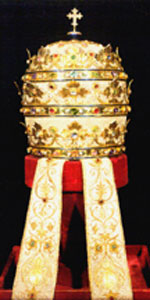
The tiara of Pope
Pius IX.
When elected, Paul VI had his choice of four tiaras – including one
given by Napoleon.[7]
The one given to Pius IX in 1870 by the
guards of the Papal States was shown off by John Paul II in an
exhibition in Denver in 1993. Shown here, it perfectly illustrates
that papal pretensions did not end with their power as princes.
It has a Latin inscription that reads,
"To the infallible Vicar of Jesus
Christ; To the supreme Governor of the world on earth; To
the father of nations and kings." [8]
Paul stopped publicly wearing them after
Vatican II, preferring to adopt a more pastoral appearance by
wearing a bishop's miter instead. This was continued by John Paul's
I and II. Benedict XVI also hasn't dusted it off, though there was
some speculation
Ratzinger might revive the
custom. He could still resume its use later. After all, there are
still a few in the warehouse.
And the Roman Church has never renounced
any claim it has ever made – including that of Boniface's.
3. Popes Who
Quit
There are some popes who quit. Thomas J. Reese, SJ, the
recently-fired editor of the Jesuit journal America, notes in
a article entitled, "Papal Transitions" that historical evidence for
papal resignations is limited, especially if one eliminates
resignations that may have been forced.
Here is his list:
-
Clement I (92?-101). Epiphanius
asserted that Clement gave up the pontificate to Linus for
the sake of peace and became pope again after the death of
Cletus.
-
Pontian (230-235). Allegedly
resigned after being exiled to the mines of Sardinia during
persecution of [Roman Emperor] Maximinus Thrax.
-
Marcellinus (296-304). Abdicated
or was deposed after complying with [Roman Emperor]
Diocletian’s order to offer sacrifice to pagan gods.
-
Martin I (649-655). Exiled by
[Byzantine] Emperor Constans II to the Crimea. Before he
died, the clergy of Rome elected a successor, whom he
appears to have approved.
-
Benedict V (964). After one
month in office, he accepted deposition by [German] Emperor
Otto I.
-
Benedict IX (1032-45).
Benedict resigned after selling the papacy to his godfather
Gregory VI. (He later tried to reclaim it. -ed.)
-
Gregory VI (1045-46). Deposed
for simony by [German Emperor] Henry III.
-
Celestine V (1294). A hermit,
elected at age of 80 and overwhelmed by the office,
resigned. He was imprisoned by his successor (the infamous
Boniface VIII, who later had him murdered. Celestine was
later canonized, while Boniface died in disgrace. - ed.)
-
Gregory XII (1406-15). Resigned
at request of Council of Constance to help end the Great
Western Schism.
Source: Patrick Granfield,
“Papal Resignation” (The Jurist, winter and spring 1978) and
J. N. D. Kelly, The Oxford Dictionary of Popes (1986).
4. Knock,
knock, who's dead?
Ancient traditions surround the end of a papal reign as well. Even
the matter of determining if the pontiff had passed to his heavenly
reward has long been
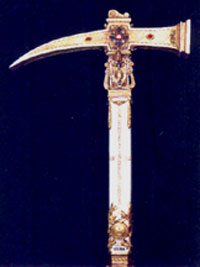 regulated
by custom. At least up until middle of the last century, no fancy
monitors or esoteric medical tests were needed. It was done simply
by hitting the pope on the head with a hammer. regulated
by custom. At least up until middle of the last century, no fancy
monitors or esoteric medical tests were needed. It was done simply
by hitting the pope on the head with a hammer.
Here's an article from the most recent interregnum:
Cardinal Eduardo Martínez Somalo
holds the title of Camerlengo, or chamberlain, of the Holy Roman
church, and that only acquires substance the moment the Pope
draws his last breath.
At that point, the Cardinal Camerlengo becomes a sort of interim
administrator, though in no sense an "acting pope". His first
duty will be to decide that the Pope really has died.
Traditionally, this has been done in the presence of the papal
master of ceremonies and various other members of the pontifical
household, by tapping the Pope on the forehead with a silver
hammer and calling out his baptismal name three times to see
whether there is any response.
Cardinal Martínez is more likely to rely on the judgment of the
Pope's team of doctors. But his chamberlain's silver hammer will
not be idle, for its other use is to break the Fisherman's Ring
- the pontiff's individualized signet ring - to ensure that no
instructions can be given out under his seal after his death.
–
The Guardian, 4/2/05
According to various sources, the
forehead tapping, done as recently as the death of John XXIII, has
been discontinued. In the rules put forth by John Paul II and
apparently followed, covering his face with a towel was the decreed
method of acknowledging his passing. However, the ring was still
smashed — the medieval equivalent of changing passwords.
John Paul II did not get all his last requests. It was said he had
asked to be buried in the earth; however, the cardinals decided that
a choice spot in the Vatican grotto was more appropriate to their
latest superstar and he was given the favored spot occupied by John
XXIII, who was moved to another location.
Truly do the Romans say,
"There's nothing so dead as a dead
pope."
Other papal burial traditions forbid
autopsies but promote displaying the corpse in state. Often the
latter tradition has proven most distressing in those cases when the
pope died in summer and decay quickly set in.
Notes
1. The Legend of Pope Joan, Peter
Stanford, Berkley Books, New York, 1999, pp. 11-12. The picture
of the chair and the woodcut of Innocent X with captions are
taken from the plates.
2. Ibid., pg. 16.
3. Vatican Treasures: 2000 Years of Art and Culture in the
Vatican and Italy, Giovanni Moello, ed., Electra, Milan, 1993,
pg. 148.
4. The Pope Encyclopedia: An A to Z of the Holy See, Matthew
Bunson, Crown, New York, 1995, pg. 55.
5. Ibid., pg. 343.
6. The Church Visible: The Ceremonial Life and Protocol of the
Roman Catholic Church, James-Charles Noonan, Jr., Viking, New
York, 1996, pg. 523.
7. The Pope Encyclopedia, pg. 344.
8. Vatican Treasures, pg. 148.
|



 male?
male?

 regulated
by custom. At least up until middle of the last century, no fancy
monitors or esoteric medical tests were needed. It was done simply
by hitting the pope on the head with a hammer.
regulated
by custom. At least up until middle of the last century, no fancy
monitors or esoteric medical tests were needed. It was done simply
by hitting the pope on the head with a hammer.